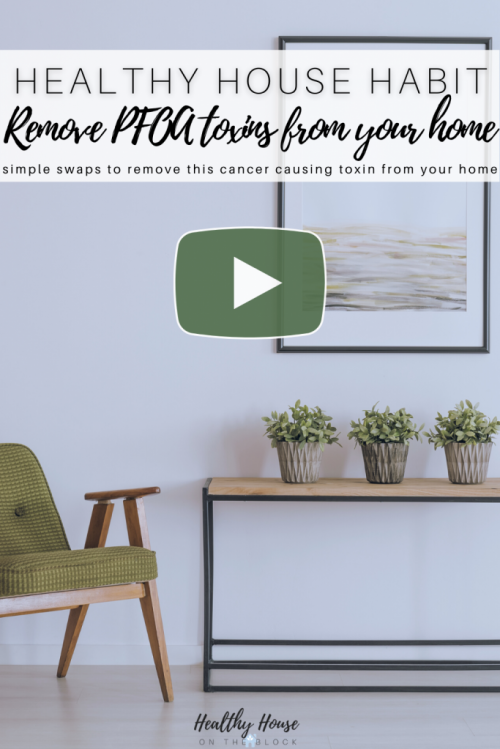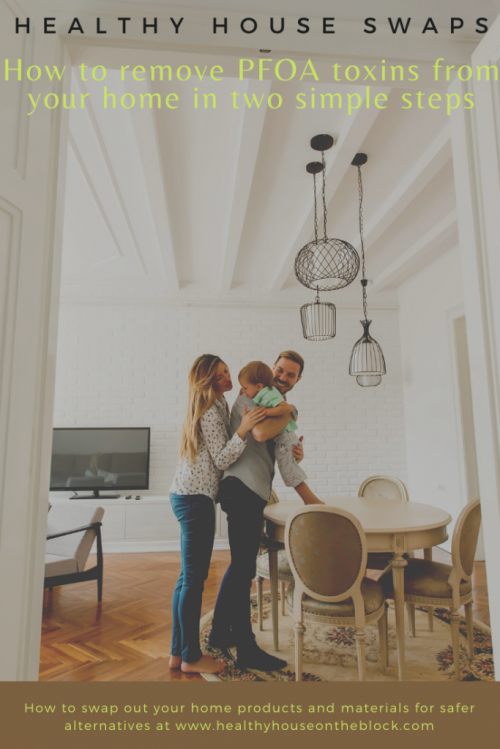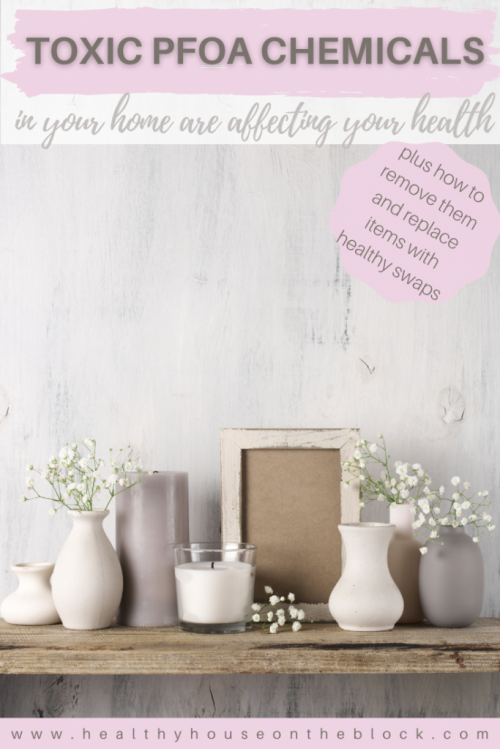
Even though I haven’t always been extremely aware of the toxins in my home, when I look back on my journey to where my home and awareness is today, I see little breadcrumbs of information and change along the way that I didn’t even know was happening. One of the very first things I was actually aware of was teflon dangers, which eventually led me to go PFOA free.
You may know that my journey started with water contamination in the city I grew up in. In my small community just on the outskirts of St. Paul and Minneapolis, I began to be bombarded with news articles about teflon dangers and the health effects from PFOAs. As a young person I began to pay more attention to what was going on in my community and made the decision that I would need to do my own research on teflon dangers and how I could make the switch to PFOAs.
Afterall, what I realized was if there were PFOA chemicals in drinking water and that was causing cancer, then why on earth was my family cooking with it? Wasn’t there just as much of a health risk cooking my food in a teflon pan with PFOAs?
And what I later realized is that PFOAs and teflon danger are in more than just pots and pans. The company who improperly disposed of the PFOAs in the first place wasn’t even using it for pots or pans. I realized this chemical was more prevalent in our home than I thought and that going PFOA free was more than just replacing pots and pans.
That year of my life in my twenties spurred on my interest in water quality and it honestly was the formative experience that pushed me forwards into removing other toxins. I didn’t start right away, as I actually didn’t realize the number of chemicals that were present in the world, in my products and right in my house.
That part of the puzzle didn’t come for a long time until I had kids and was just more interested in keeping my whole family healthy. But that experience has always reminded me that I can’t just trust that everything around me is safe and healthy. It was a huge wake up call that gave me the confirmation I needed to start looking into toxins on my own rather than just trusting that everything was safe.
So, this week I’m going to take you on a deep drive of teflon dangers and how you too can go PFOA free at home.
WHAT IS PFOA?
PFOA, or Perflourooctanic acid is the main compound in teflon and other solutions that give products a “water resistant” coating. Do you ever notice water beading off of something like carpet or fabric? It means it was treated with a protectant that prevents water and staining from affecting the product. THIS coating is made primarily with PFOAs.
PFOA is an industrial surfactant and chemical compound in the simplest form.
A short list of where PFOA is used (which can ultimately help us go PFOA free) looks like this:
- Leather
- Adhesives
- Waxes
- Carpet
- Heat resistant tape
- Polishes
- Paint
- Protective sprays
- Coatings for upholstery
- Waterproof clothing
- Non-stick pans
- Cleaning products
The largest problem with PFOA and teflon dangers is that this chemical has an extremely long life and it’s being found that it breaks down extremely slowly. It has also had a HUGE impact on our environment. This chemical has been used since the 1950s and human exposure and environmental contamination has increased since them causing large problems within our homes and environments due to this toxin.
Through the improper dumping of this chemical as well as just our everyday use habits and our massive amounts of trash, PFOAs are being found in groundwater, which not only is killing animals and fish, but is also infiltrating private wells and drinking water sources. (EPA Information)

WHAT ARE TEFLON DANGERS IN TERMS OF HEALTH?
Teflon dangers and PFOA chemicals are really problematic to health in several different ways. First, as I mentioned before the chemical does not break down quickly in the environment and in humans it has a half life of 3 years. This means that PFOAs are not metabolized by the body and it stays in the body for YEARS, where it builds up and affects various organs. (RESEARCH)
Two communities in Minnesota and Ohio that had exceptionally large exposures were studied at length in terms of the health effects and long term problems with PFOAs. These potential health risks include:
- Increased risk of diabetes
- Decreased immune function and immune disorders
- Liver toxicity and liver problems
- Cholesterol changes
- Thyroid dysfunction
- Increased risk of cancer
The unfortunate part of teflon dangers and PFOAs is that not only are we being exposed to this toxin within our own home, where we have control, but we’re also being exposed to this chemical outside our home and in our water sources, which are more difficult to control. This is why it’s so incredibly important to limit the sources of PFOAs in our homes where we can.

HOW TO GO PFOA FREE
So HOW do you go about reducing your teflon dangers risk and going PFOA free? The first step is assessing what you have in your home in terms of products that contain this chemical. Looking at the list items that typically have PFOAs on or in them will give you an idea of products you want to be buying PFOA free.
In my opinion, there are two things you should take into consideration when it comes to teflon dangers and going PFOA free:
- What do I use or come in contact with on a daily basis (or multiple times throughout the day)?
- What takes up the most surface area in my home (think paint, flooring, furniture, etc.)
It’s also a good idea to think about the three ways we come in contact with toxins: inhalation, ingestion and absorption. Anything that causes you to ingest this chemical toxin, goes to the top of the removal list for me. This is especially true of the teflon dangers in pots and pans.
Next look at items that are sitting on you skin for long periods of time. This may include bedding, waterproof clothing and upholstered furniture.
Finally, paying attention to the dust that may be created by certain materials such as carpet and upholstery foam. This dust can enter our airways and end up being inhaled into our bodies.
It’s important to remember that this toxin has a half life of 3 years, meaning each time you come in contact with the chemical it ends up building up and staying in your body and your systems for a long period of time.

SAFE ALTERNATIVES TO PFOAS AND TEFLON
Going PFOA free doesn’t have to be difficult or overwhelming. Make a simple list of items you’d like to eventually get rid of and start going to work finding alternatives. I keep my list of toxin free swaps in my phone and as I have time or more in my budget for each item, I slowly check the toxic items off my list.
Pots & Pans: Check out this post about toxin free pots and pans to help you steer clear of teflon dangers and find pots and pans that are PFOA free. Stick to stainless steel, cast iron and 100% ceramic with a lead free glaze.
Cleaning Products: I’ve written A LOT about cleaning products and how you can go about avoiding a number of toxins, including PFOAs. This post will walk you through all the approved store-bought cleaners as well as give you some recipes for making your own cleaners. Or, if you know you’d like a concentrated green cleaner, this post is for you.
Carpet: Carpet is often treated with a protectant to repel liquid and stains. This repellent often contains PFOAs and can begin to create tiny particles that end up in our HVAC systems and in the dust throughout our home. Carpets are particularly concerning when you have children or babies lying on the floor or playing. This post is going to help you iron out which carpets are safe and how to find ones that are low toxin for your home.

Cosmetics: I love using the ThinkDirty App for cosmetics in order to find a healthy and safe version for myself. I think it’s so important, especially since it goes directly on my skin and my skin absorbs whatever is in this product all day long. This post about the ThinkDirty App will help walk you through how to use and how to find PFOA free products for your cosmetics and personal care products.
Paint: Paint I think is only necessary to change if you’re going to be painting anyways. I don’t know that I would recommend someone repaint just to repaint and cover up toxins. But, if you will be painting a space in your home, this guide will walk you through the best non-toxic and low toxic paints that are PFOA free as well.
Upholstery: Upholstery and mattresses is a HUGE contributor to PFOAs and other teflon dangers in our homes. Making sure the products we have in our home contain safe foams and upholstery fabrics is HUGE as we spend a lot of time on these surfaces. It’s also important to note that our bodies are both warm and contribute to humidity, which increase the level of off-gassing that happens on these surfaces. This post about mattresses will help you find a toxin free mattress and this post about furniture will help you not only use what you have but find healthier new options if necessary.
Organic Clothing: While this blog is not really about fashion, I do think if you’re wearing a lot of waterproof clothing, you should reassess. Make sure that clothing is made of natural fibers and even organic if you can. Keeping a product that contains PFOAs right next to your skin can be extremely harmful to your health as it is sitting on your body’s largest organ for long periods of time.



Pingback: Toxin Free Workout Equipment for Home (Plus Organic Workout Gear) - Healthy House on the Block
Pingback: Frequently Dirty Air Filter? Air Duct Cleaning is the Answers - Healthy House on the Block